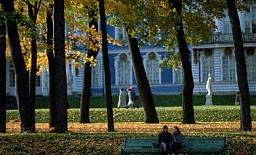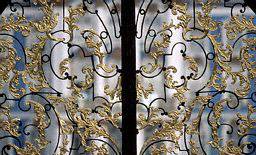 Pushkin Park |
 Cathrine Palace |
The Outer Regions
Pushkin
The town of Pushkin (called Tsarskoye Selo before 1917, Detskoye Selo in 1918-37) arose in the early 18th century as one of the tsarist residences. The Catherine Palace (1717-23; enlarged by Aleksey V. Kvasov and Savva I. Chevakinsky, 1743-48; rebuilt by Rastrelli, 1752-57) is notable for its dimensions, the beauty and majesty of its form, and the wealth of its sculptural decoration. The golden suite of splendid halls (including the Amber Room) exemplifies Russian Baroque at its peak. The community also is the site of the Chinese Village (1782-96) in Alexander Park and the gallery (1780-90) named after its architect, Charles Cameron, the terraces of which contain more than 50 busts of figures from ancient Greek and Roman history. The Lycée, a school for the offspring of the nobility, had the great Aleksandr Pushkin as a student, and a famous statue of the poet stands near the town's Egyptian Gates. The town suffered severe damage during the German onslaught but has been restored.
Pavlovsk
Pavlovsk, a southern suburb, is the site of a late 18th- and early 19th-century palace and park in the classical style that was created as a country residence for Tsar Paul I. The central Great Palace (1782-86; Cameron) is crowned by a dome supported by 64 columns. It was severely damaged by the Nazis and has been restored.
Gatchina
Another southern suburb, Gatchina, is noted for the palace built in 1766-81 by Antonio Rinaldi for Count Grigory Orlov, a favourite of Catherine II. Gatchina Park was created at the same time. Its monuments, sculptures, and gardens, like those of all St. Petersburg, are preserved by the state.
Next | Main Page | About | Mail Us